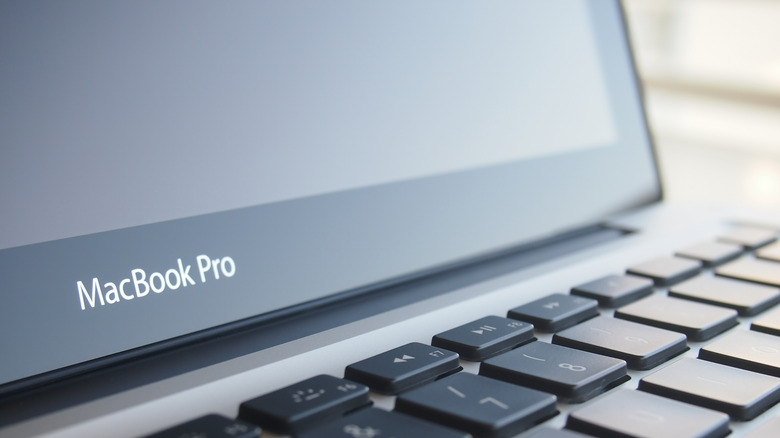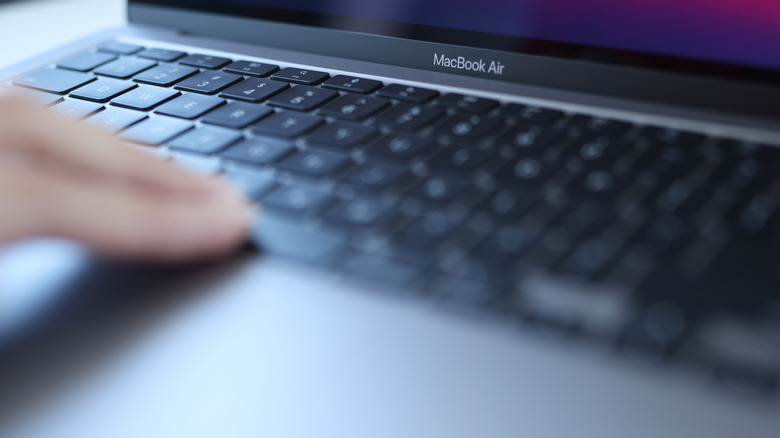Why Your MacBook Screen Is Black (And How To Troubleshoot The Problem)
Plenty of people use MacBooks (both the latest models and older offerings) for work and at home. But despite Apple's pedigree, its hardware does run into problems from time to time. Seeing a black screen on a laptop isn't something to worry about most of the time, but it can become a pretty significant issue when it won't go away. At best it may leave you trying to navigate around your system with no visual indicators, and at worst it could be the result of an internal hardware failure — in which case you'll need to contact Apple Support for repairs.
Before you resort to a trip to a repair center, there are some other troubleshooting methods you can try. As long as the problem is software-related you might be able to sort it out for yourself. There's even a chance that a simple adjustment to your settings will take care of it all.
The most common reasons a MacBook display is black
The two most likely reasons your MacBook screen has gone dark also happen to be very easy to remedy. For starters, try pressing a key on the keyboard or clicking the trackpad or mouse button. If the screen lights up and returns to normal, it was in power-saving Sleep mode.
You can adjust Sleep settings by clicking the Apple icon in the top-left corner and selecting System Settings (or System Preferences in macOS 12 Monterey and older), then clicking Lock Screen (Energy Saver in macOS 12 and older). From there, adjust the "Turn display off" settings to increase or decrease the amount of inactivity time before it shuts off — or turn the function off entirely so it will stay on.
Alternatively, a black screen could mean your MacBook is out of power. If that's the case, unplug any external devices connected to your MacBook, then plug in the MacBook's power adapter. Once the MacBook is plugged in, it should turn back on when you press the Power button. If it doesn't, hold both the Command and Control keys on the keyboard and then press the Power button to restart. Not all unexpected black screens are related to energy consumption, however.
Your MacBook's black display may be due to the startup disk
Your MacBook sticking on a black screen when you start it up is likely due to a problem with the macOS startup disk.
- Press and hold the Power button for 10 seconds to turn your MacBook off (if it's on).
- Press the Power button to turn it back on and see if it progresses past the black screen. If not, press and hold the Power button for 10 seconds to shut the MacBook down again.
- For a Silicon MacBook, press and hold the Power button until you see the Options and System Volume buttons. Then click Options and select Continue.
- Choose a volume to recover (if requested), then select an admin account to log in with and click Next. Enter the account password and select Continue to enter Recovery Mode.
- For an Intel Macbook (2019 and older), push the Power button and then immediately press and hold the Command and R keys. If prompted, enter your MacBook's password.
- Select a volume to recover, if asked, then choose and sign in with an admin account.
- With Recovery Mode running, open Disk Utility and click on Macintosh HD in the sidebar.
- Click the First Aid tab along the top of the window, then select Run (or Repair if Run doesn't appear).
- Wait for Disk Utility to locate and repair any errors, then restart your MacBook.
If Disk Utility can't find errors, or if you still see a black screen after startup, try reinstalling macOS. Otherwise, you should contact Apple Support for additional help.
Your MacBook may be stuck on the lock screen
MacBooks can also sometimes get stuck on the lock screen after entering Sleep mode.
- Shut down your MacBook by pressing and holding the Power button for 10 seconds. Press the Power button again to restart.
- If the black screen persists, shut the MacBook down again.
- Push the Power button, then immediately press and hold the Command, Option, P, and R keys until you see the Apple logo.
- If the problem persists, try restarting your MacBook in Safe Mode.
- For an Apple Silicon MacBook, press and hold the Power button until Options appears on the screen.
- Click Options, then select your startup disk (the default name is Macintosh HD). Press and hold Shift on the keyboard and click Continue in Safe Mode, then log in if prompted.
- For an Intel MacBook (2019 and older), push the Power button and then immediately press and hold Shift on the keyboard until you see the login screen.
- Click the Safe Boot button in the top-right corner of the screen.
- Once your MacBook starts up in Safe Mode, check to see if it still sticks on the lock screen. If it does, you may need to reinstall macOS.
- If the problem doesn't occur in Safe Mode, restart your MacBook normally and see if the black screen issue comes back. If it doesn't, it's possible that running Safe Mode cleared up the error.
If the black screen comes back outside of Safe Mode, get in touch with Apple Support.



